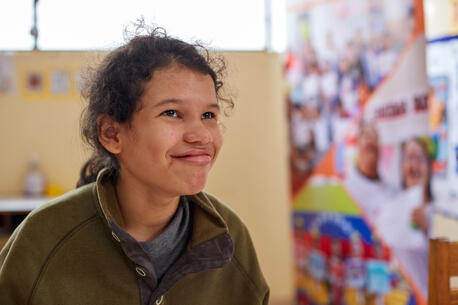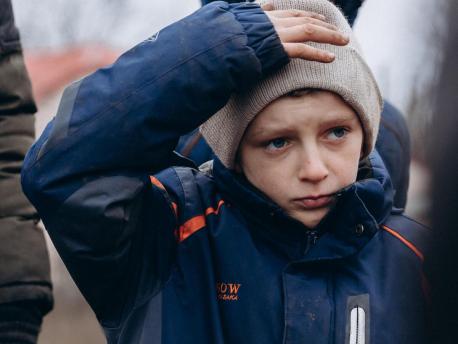
The Case for Investing in UNICEF's Work
UNICEF's strategic plan for 2022-2025 — developed with input from more than 200,000 young people, an unprecedented level of engagement to ensure alignment with youth views and priorities — features cross-cutting programs in gender equality, climate action and other areas. Continued support from partners is needed to achieve maximum impact for children.
UNICEF has always believed that children have a right to say what they think and have their opinions taken into account — that those opinions should be a driving force for change in the world, guiding UNICEF’s global work.
To help develop its strategic plan for 2022-2025, UNICEF asked children and young people in 30 countries to share their views and priorities, engaging some 200,000 individuals — an unprecedented number — through U-Report, Voices of Youth and other means.

Through these consultations, UNICEF learned or reaffirmed a number of things regarding what young people care most about. For instance:
- children and young people want safe homes and schools
- they want parents and teachers to respect their agency
- schools are essential — not just for education but also other critical services, and for social connection and collective youth action
- mental health and psychosocial support are crucial for young people to stay healthy and safe and to keep learning effectively
- climate change is a burdensome and alarming reality
- young people are significantly impacted by racism, gender inequality and other forms of discrimination
- living in humanitarian and protracted crises further compounds any and all of the above
UNICEF's plan for the the coming years takes all of these concerns and priorities to heart. Here is a look at five cross-cutting program areas — climate action, disability, gender equality, peacebuilding and resilience.
Within each, UNICEF is committed to better understanding and addressing the root causes of inequity for children, particularly those who suffer the worst deprivations and are most excluded from society.

Identifying climate action, disability, gender equality, peacebuilding and resilience as cross-cutting focus areas is an important step toward understanding and addressing root causes of inequity for children — a vital part of UNICEF’s approach to leave no child behind
In a related appeal for donor support for the plan, UNICEF makes the case that investing in these efforts will reap huge dividends not just for individual children's futures but for whole communities and countries and society as a whole — a society in which every child is included, without discrimination, and has agency, opportunity and their rights fulfilled.
There are five child-centered goal areas, covering all a child needs, from antenatal care through infancy, childhood and adolescence, laddering up to UNICEF's long-term vision for every child. Here's a breakdown of each goal area and the actions UNICEF has identified as critical for accelerating results:
Goal Area 1: Every child survives and thrives with access to nutritious diets, quality primary health care, nurturing practices and essential supplies
Going forward, UNICEF aims to accelerate results by strengthening primary health care and systems; addressing deep inequalities in access to essential health and nutrition services; scaling up capacity to respond to public health emergencies; promoting child-centered food systems; and changing discriminatory laws, policies and social practices.
Programs and partnerships that fall into this first bucket all contribute to reducing child mortality; specifically, those that boost immunization coverage to eradicate polio, end maternal and neonatal tetanus, prevent outbreaks and fight other vaccine-preventable illnesses; improve access to HIV testing, treatment and care for women, children and adolescents and prevent new HIV infections; increase access to mental health services; promote breastfeeding and prevent and treat malnutrition.
Goal Area 2: Every child learns and acquires skills for the future
UNICEF works globally to improve access to learning — including helping schools reopen and stay open safely during a pandemic — and the quality of education from early childhood through primary and secondary school. For older children, UNICEF works with partners to provide opportunities to develop life skills, digital skills, transferrable skills and vocational skills for specific jobs.
Priorities for accelerating results going forward include: strengthening the emphasis on early learning; improving education for marginalized adolescents; focusing on safe and supportive school environments; strengthening links between education and other systems like nutrition and mental health; innovating around skills building and providing multiple learning pathways; and supporting digital learning.

Goal Area 3: Every child is protected from violence, exploitation, abuse and neglect
Priority programs under child protection aim to support children's recovery from the psychological impacts of trauma; work with governments to ensure children's rights are respected within legal and justice systems; increase knowledge and change community attitudes to end child marriage, female genital mutilation and other harmful practices; and safeguard the rights of children on the move, who are the most vulnerable to danger, detention, deprivation and discrimination.
To accelerate results for these interventions in the years ahead, UNICEF plans to put greater focus on prevention, targeting children at greatest risk; advocate for more inclusive social protection systems; and better address the behavioral, social, cultural and economic determinants of harm and harmful practices while strengthening access to response services. UNICEF programs also aim to empower families, parents and caregivers to better protect children.
Goal Area 4: Every child lives in a safe and sustainable climate and environment — with sufficient access to safe water, sanitation and hygiene (WASH) services
Climate change, weak local and national governance, unplanned urbanization and insufficient awareness of the dangers posed by environmental risks – including inadequate water and sanitation systems – expose millions of children to potential harm. UNICEF's work in this area focuses on strengthening WASH service delivery and WASH systems — handwashing facilities and toilets in schools, communities and health centers — and empowering communities to raise public awareness around the dangers of unclean water and poor sanitation and importance of adhering to best hygiene practices.
In the area of climate change, UNICEF also works with partners to mitigate impacts of environmental hazards on children’s health, and to equip communities with knowledge, skills and supplies needed to protect against natural disasters. To accelerate results, UNICEF will be looking to increase partnerships with the private sector.
Example of climate action: In the Fulani village of Hore Mondji, southern Mauritania, a women's cooperative uses solar energy to operate the borehole that supplies the community garden with water. The project, piloted by UNICEF in partnership with local authorities, supports the continued production of fruits, vegetables and aromatic plants — okra, carrots, mint, peppers, eggplants, tomatoes — some for local consumption, ensuring healthy diets, and some to be sold in neighboring town markets, generating income for co-op members.

Goal Area 5: Every child lives free from poverty
UNICEF notes that the impacts of the COVID-19 pandemic have hit children the hardest — wreaking havoc on the world’s health and education systems, and causing the first increase in extreme monetary poverty since 1998. In 2020, UNICEF data show, 150 million more children fell into multidimensional poverty due to COVID-19.
Inequity and deprivation perpetuate poverty across generations. Geography, conflict, discrimination, exclusion and other barriers have lifelong consequences for children and society.
UNICEF's work helps to make children living in poverty visible, whether it's by supporting governments with implementation and financing of poverty reduction policies, or strengthening social protection systems to ensure they are inclusive, shock responsive and gender sensitive.
UNICEF uses cash transfers to help alleviate the effects of poverty on families in emergencies and other humanitarian contexts and to accelerate results. "It is vital that those who have been most affected by the economic crisis are supported to recover, so that children can be protected from risks like child labor and child marriage and families can be lifted out of poverty," the strategic plan states.
Even before the COVID-19 pandemic, humanitarian needs were on the rise due to conflict and climate change. Today, 1 in 33 people worldwide need humanitarian assistance and protection – the highest number in decades. As noted in the plan: "Responding to these growing humanitarian crises requires us not just to meet children’s immediate needs; we must also help communities to develop stronger health, education and shock-responsive social protection systems for the long term, so that they are more resistant to future risks."
Partnering with UNICEF means maximizing results for children
As a child- and youth-powered organization, UNICEF has always, and will continue to, support youth engagement in public policy decisions; to work with youth as problem solvers who can help advance innovative solutions; and to support youth collective action for large-scale, long-lasting change.

Children should not have to struggle to have their basic needs — for health care, nutrition, shelter, protection, education, safe water, hygiene and sanitation — met. Help realize the rights of every child and improve their outcomes in life.
UNICEF relies on voluntary contributions from public and private individuals and entities. UNICEF USA recognizes that some partners may want to direct their support to a particular program of work, aimed at achieving specific results; and that some prefer to combine financial investment with advocacy and technical expertise. UNICEF USA can help establish a strategic partnership that aligns with your company's or organization's goals while also contributing toward UNICEF’s strategic plan for children. Reach out today.
The best way to support UNICEF's work for children is with a contribution to UNICEF's Core Resources for Results, where funding is flexible and can be used without restrictions within UNICEF's plan for children, maximizing impact. Please donate.
HOW TO HELP
There are many ways to make a difference
War, famine, poverty, natural disasters — threats to the world's children keep coming. But UNICEF won't stop working to keep children healthy and safe.
UNICEF works in over 190 countries and territories — more places than any other children's organization. UNICEF has the world's largest humanitarian warehouse and, when disaster strikes, can get supplies almost anywhere within 72 hours. Constantly innovating, always advocating for a better world for children, UNICEF works to ensure that every child can grow up healthy, educated, protected and respected.
Would you like to help give all children the opportunity to reach their full potential? There are many ways to get involved.





